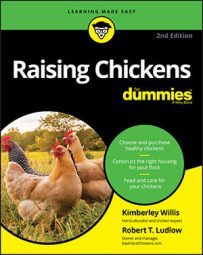In the not-so-distant past, most meat chickens were young males that were the excess offspring from laying or show birds. They were kept just long enough to make a good meal — and that usually meant about 5 to 6 months of feeding and caring for the young roosters. The excess males in most heavy, generally brown-egg-laying breeds of chickens were used as meat.
And in your great-grandparents’ day, any hen that quit laying was also used for meat.
About 50 years ago, breeders began to create hybridized strains of chickens specifically for meat. They grew fast and gained weight quickly on less feed than other chickens. They had more breast meat, something consumers seem to want.
![[Credit: Illustration by Barbara Frake]](https://www.dummies.com/wp-content/uploads/470044.image0.jpg)
Over the years, these hybrids — particularly one hybrid, a cross between White Rocks and White Cornish breed chickens — have dominated the commercial meat market. In fact, almost every chicken you can buy in a grocery store is a strain of the previously mentioned cross.
Most meat birds stem from one hybrid, but home flock owners can consider other good meat breeds as well. Many backyard breeders are trying to develop meat breeds that grow quickly and have good meat yield, but are hardy and active enough to do well in pasture or free-range situations.
The meat of these other meat breeds may taste slightly different if the birds are raised on pasture and take longer to grow. The meat is a little firmer, and there’s less breast meat. The taste is described by some as “old-fashioned” chicken flavor, which is hard to describe unless you’ve eaten both types.
If the chickens eat commercial feed and aren’t allowed to get too old before butchering, the older type meat birds taste much like hybrid meat birds. The advantage of hybrids is that they grow about twice as quickly and on less feed than conventional meat breeds.
Cornish X Rock hybrids: Almost all chickens sold for meat today are a hybrid of White Cornish and White Rock chickens. They’ve been tinkered with until we now have an extremely fast-growing bird with huge breasts. They’re often ready to butcher at 10 weeks, and they do a remarkable job of converting feed into meat. They have soft, tender-textured, bland-flavored meat and lots of white breast meat. Both sexes make good eating and grow at nearly the same rate. If you have eaten only store-purchased chicken, you certainly know how they taste.
Different strains exist, even some where feather color has been introduced. Basically, however, commercial meat birds are Cornish-Rock crosses. These birds have special nutritional needs and aren’t good for free-range or pastured poultry. They’re excellent if you want quick, plump meat birds, but they’re not good for anything else.
These breeds gave up some features to achieve these “meat goals.” They’re extremely closely related genetically, with three or so large firms controlling the production of parent stock. They have to be managed carefully and fed a high-protein diet to avoid problems with their legs and hearts. Basically, they’re basketballs with feathers, they’re inactive, and they spend most of their time eating. They can’t reproduce normally.
Cornish: The Cornish is an old breed known for its wide stance and big breasts. Several colors other than the white ones used to make meat hybrids exist, including red, buff, and laced patterns. They have a rose comb, and their feathers are tight and sleek. These birds are poor layers of small white eggs; some will brood. They can be aggressive with each other, but they’re fairly tame with keepers. Cornish chickens are only fair foragers and are better raised in pens.
Jersey Giants: This American breed comprises the world’s largest chickens. They come in black or white. They’re meaty birds, but they grow slowly. Jersey Giants are fairly good layers of medium-size brown eggs. They’re calm, they’re good at foraging, and they make good brooders.
Freedom Rangers/Red Rangers: These birds were developed to be good pasture-fed meat birds, primarily for the organic meat market. They thrive on lower-protein feed and are better foragers than Cornish-Rock crosses. Most are red in color, with a few barred or black spotted feathers; gray and “bronze” colors are also seen.
These birds take a few weeks longer than the Cornish-cross broilers to be ready to butcher, but many people think they taste better. They’re also less likely to suffer from leg problems or die of heart failure than the Cornish-cross broilers. Rangers can be hard to find, and the breed still has a lot of variability: Some birds mature faster and have more meat than others.

